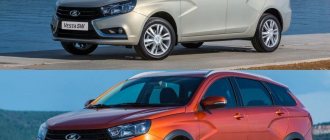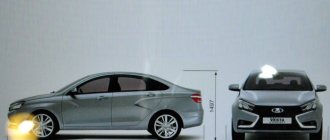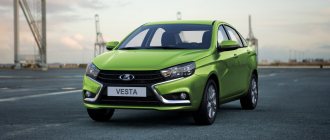Almost simultaneously, there were two more elevated passenger cars on the Russian market. AVTOVAZ launched the long-awaited Vesta SW Cross, and Kia responded with a special configuration of the Rio hatchback with the X-Line prefix. The starting price of a domestic car is 755,900 rubles; for a “Korean” they ask from 774,900 rubles. The cost makes it clear that these newcomers are direct competitors. Which one you prefer depends on what car parameters are important to you.
|
Kia Rio X-Line |
Adaptability to bad roads
On off-road terrain, the Lada Vesta SW Cross will give a Korean car a run for its money. According to the official specifications, the lowest point of its body is 203 mm from the ground, while the Kia's ground clearance is only 170 mm. This is even less than stated for regular Vests (178 mm), but by passenger standards the figure is not bad. Considering that Vesta’s wheelbase is only 35 mm longer than that of the Rio X-Line (2635 versus 2600 mm), from the point of view of geometric cross-country ability, Lada looks like a more correct option.
Vesta has ground clearance of 203 mm versus 170 mm for Rio. But the Kia is equipped with more practical high-profile tires.
Vesta has ground clearance of 203 mm versus 170 mm for Rio. But the Kia is equipped with more practical high-profile tires.
Exterior and interior
Vesta SW Cross, according to automotive experts and publications, is the most beautiful car created by AvtoVAZ. Successful design solutions taken from the front-wheel drive sedan are effectively implemented in the new body.
The car received a bright appearance, a neat plastic body kit, and stylish wheels. As a result, the Lada car is superior to the nice, but more modest “Korean”.
The loser is the front part of the new Rio, which smacks of bad taste and “Chinese”, despite several original solutions. But the rest of the car was a great success for the Kia design department. The rear optics and dual exhaust pipes deserve special praise.
Conclusion. Vesta looks nicer compared to the Rio hatchback with an off-road body kit and other all-terrain station wagons. The new AvtoVAZ car looks better in the special “Mars” color scheme.
Capacity
The Lada Vesta SW Cross is larger than the Korean car: 4424 mm in length and 1785 mm in width versus 4240 and 1750 mm, respectively. And Vesta’s wheelbase is a little longer, as we have already found out. That’s why the Lada passengers will have a little more space.
As for the luggage compartment, it is obvious that the station wagon has more room than the hatchback of the same class. We haven’t had time to measure the Rio X-Line’s trunk volume yet, so we’ll rely on factory data. The manufacturer promises 390 hp. Vesta claims much more - 480 hp. Both indicators are given based on loading “under the curtain”. In the Lada, the volume of the cargo compartment is limited by the littered rear pillars, but it still surpasses the Kia in terms of maximum capacity. So if you plan to frequently load your car to capacity, Vesta SW Cross is your choice.
The domestic model loses in terms of the maximum level of safety: it has only four airbags. But they are already provided in the “base”, while Kia will have only two pillows, if you are not ready to pay at least 965 thousand rubles for one of the top versions.
The domestic model loses in terms of the maximum level of safety: it has only four airbags. But they are already provided in the “base”, while Kia will have only two pillows, if you are not ready to pay at least 965 thousand rubles for one of the top versions.
Interior
If we do not consider the issue of configurations, and simply evaluate the interior of both cars, then we can admit that the KIA Rio X Line is better than the Lada Vesta SV Cross, although there is still no overwhelming advantage.
KIA pleases with the quality of its work. The plastic is inexpensive, but you can’t fault the build quality, and its texture is very pleasant. The ergonomics are well thought out, especially the dashboard, which looks good and is easy to read, and the keys are pleasant to the touch. The interface of the multimedia system is simple and clear.
We are pleased with the well-organized central tunnel with a pair of cup holders, a place for a smartphone and a spacious niche right next to the center console.
The seats are soft, although there is no lumbar support. The rear sofa is very cozy, but a little small, and therefore you will have to make room a little in the gallery. The trunk in its normal position is so-so, but with the rear seat folded down it will give Vesta a head start. Visibility is also disappointing, although the A-pillars are not too wide.
As for the interior of the Lada Vesta SV Cross, it outperforms its competitor in some respects. In particular, there is lumbar support in the seats, the mirrors are noticeably larger, and the seating geometry is comfortable. The second row is significantly more spacious than in the X-Line, and the trunk is larger, although when unfolded it is still inferior to its counterpart.
But there are also shortcomings. This concerns, first of all, the quality of materials and workmanship. Of course, SV Cross is a big step forward, but it still falls short of KIA. There are some annoying miscalculations in ergonomics - it’s inconvenient to fasten seat belts due to the fact that the lock is too recessed, the front seat headrests protrude too far forward, and controlling the on-board computer and multimedia is also not the easiest.
The glove box lid is equipped with a microlift, but it works so-so, the steering column switches are clumsy. Well, the power window unit, borrowed from Granta, looks completely miserable.
Comparing the interior of the Lada Vesta SW Cross with the Kia Rio X-Line, you pay tribute to the big step forward on the part of the designers of the domestic car.
Lada-Vesta-SW-Cross: Simple but comfortable seats with lateral support, beautiful, even stylish dashboard design. But you can recognize the smell of domestic plastic when you open the door slightly.
Against the backdrop of a decent implementation of complex technical solutions (an excellently debugged navigation system), there are offensive punctures in small things - the radio is annoying with a multi-second delay when turned on, power windows with sloppy frames risk unpleasantly damaging your fingers, and the original markings and illumination of the speedometer scale are not convenient for all drivers.
In the Kia Rio X-line, simple lines and even inexpensive materials look great. The central screen is facing the driver and is easy to read even in sunny weather, which cannot be said about Vesta’s screen.
A leather-wrapped steering wheel with the correct diameter, strict inserts, more comfortable seats - all this adds up to make you feel that the car is more expensive than it actually is. Of course, this is true primarily for the top versions of the Rio X-line, but even they do not have a frightening price.
In contrast to the bright design of the Vesta SW, the Rio's interior is conservative and restrained. However, there are no complaints about the quality of materials and workmanship; we are pleased with the pleasant little things that are not available in Vesta SW at any price.
Engine and gearbox
The Koreans did not highlight the interior of the pseudo-crossover with any decor. The most expensive configuration includes eco-leather trim. A dubious advantage, given the quality of this material.
The Koreans did not highlight the interior of the pseudo-crossover with any decor. The most expensive configuration includes eco-leather trim. A dubious advantage, given the quality of this material.
Vesta flaunts dynamic markings in the image from the rear view camera. Rio responds with two options for the multimedia system. One has its own navigation, the other can only broadcast it from the screen of the owner’s smartphone.
Vesta flaunts dynamic markings in the image from the rear view camera. Rio responds with two options for the multimedia system. One has its own navigation, the other can only broadcast it from the screen of the owner’s smartphone.
All versions of the Kia Rio X-Line have a warm steering wheel. Perhaps in the future this option will appear in Lada.
All versions of the Kia Rio X-Line have a warm steering wheel. Perhaps in the future this option will appear in Lada.
Kia offers a choice of two petrol engines for its lifted hatchback, with a power of 100 and 123 hp. The Lada engine line includes comparable units of 106 and 122 hp. So there is parity in power. As well as in terms of acceleration dynamics. The “Korean” covers the first 100 km/h in 10.7–13.4 seconds, depending on the power unit. Lada - in 11.2–13.3 seconds. Both cars allow the use of AI-92 gasoline, but Kia is more economical. Fuel consumption for the Rio X-Line in the combined cycle varies from 5.9 to 6.8 l/100 km, while for the Lada it ranges from 7.5 to 7.9 l/100 km. Of course, real figures will differ from those stated, but official measurements were carried out using a single methodology, so we have the right to compare them.
The Koreans offer a modern 6-speed automatic transmission as an option, for both engines. The domestic car has only a robot with one clutch, which only the laziest would not kick for slowness. Moreover, it is available exclusively in combination with a 122-horsepower engine. So for fans of a comfortable and at the same time dynamic ride, Lada can only offer a manual version.
|
A rear folding armrest with a pair of cup holders is an attribute of Vesta with the Prestige package. Kia doesn't have that. |
Heated rear seats have become the norm for B-class budget employees. Both cars are equipped with it in the two most expensive trim levels. | |
Features of vehicle bodies
The Kia Rio is supplied to the market in two body styles – sedan and hatchback. At the same time, the Lada Vesta only has a sedan body. Engineers from the domestic manufacturer promise the release of station wagon and coupe body modifications for Vesta in the near future.
When choosing a Lada Vesta or Kia Rio, you should pay attention to the dimensions of the cars:
- Length. In the Kia Rio, this parameter is 4,380 millimeters. At the same time, the domestic vehicle can boast a length of 4,410 millimeters.
- Width. The creation of the Korean automobile industry has a width of 1,700 millimeters. The width of the Lada Vesta is 1,764 millimeters.
- Height. This Kia characteristic is 1,470 millimeters. Domestic engineers designed a body with a height of 1,500 millimeters.
- Ground clearance. The clearance of Rio and Vesta cars is 160 and 178 millimeters, respectively.
- Weight. An empty domestic vehicle weighs 1,230 kilograms. The Korean car is significantly smaller – 1,055 kilograms.
- Wheelbase. The characteristics of this parameter are 2,640 millimeters for Lada Vesta and 2,570 millimeters for Kia Rio.
- Trunk capacity. The luggage compartment volume in the Korean is 470 liters. The domestic car has a slightly larger trunk, the size of which is 480 liters.
By comparing the above parameters, we can draw some conclusions in comparing the Kia Rio and Lada Vesta cars. The domestic car has large dimensions and can boast of having the highest ground clearance in its class.
The representative of the Korean automaker can boast of a smaller mass.
Options for gearboxes in Rio and Vesta
The Lada Vesta car, like the Lada X Rey model, can be equipped with the following transmissions:
- Domestic five-speed manual gearbox. This transmission is a seriously modified Russian gearbox from the Lada Priora. AvtoVAZ engineers have significantly improved many transmission components using foreign spare parts.
- French-made five-speed manual transmission.
- Robotic manual gearbox. Unlike an automatic transmission, this transmission is easy to maintain and repair.
Perhaps with the release of Vesta as a station wagon, engineers will add a full-fledged automatic transmission to this vehicle.
Kia Rio and Rio Xline vehicles can be equipped with:
- Five-speed manual gearbox.
- Six-speed manual transmission.
- Four-speed automatic transmission.
- Six-speed automatic transmission.
Thanks to the presence of full-fledged automatic transmissions with high reliability and durability, Kia Rio cars have practically no competitors in their price range.
It is important to note! In the Lada Vesta, acceleration strongly depends on the type of transmission - with a manual transmission the car starts much faster than with a manual transmission.
Car design and exterior
An important parameter in comparison, allowing you to understand which is better - Kia Rio or Lada Vesta, is the design of the vehicle. In this regard, both cars make an amazing impression.
Both body versions have modern design solutions. Kia Rio X-line and Lada Vesta are very attractive cars in terms of body appearance.
The characteristic features of the Kia Rio design are:
- the presence of a large number of flowing body features;
- spectacular radiator grille;
- narrow optics of front and rear lighting devices;
- framing the side panels with stylish accessories;
- neat execution of the luggage compartment.
With Lada Vesta, too, everything is not so clear. A car from domestic engineers can boast:
- classic design of front lighting fixtures;
- powerful air intake;
- memorable radiator grille;
- profile disks;
- stylish appearance of the rear.











